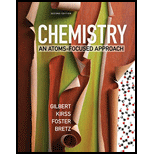
To:
(a) Calculate the empirical formula of xanthotoxin.
(b) Calculate molar mass and molecular formula of xanthotoxin.
Answer to Problem 11.96QA
Solution:
(a) Empirical formula of xanthotoxin is C3H2O
(b) Molar mass of xanthotoxin is
Explanation of Solution
1) Concept:
Part a) we are calculating the empirical formula using given masses of CO2 and H2O.
Part b) the freezing point depression formula can be used to find number of moles of solute (xanthotoxin).
From moles and given mass in grams, we can find molar mass of xanthotoxin in g/mol. From empirical formula mass and the calculated molar mass, we can find molecular formula for xanthotoxin.
A mole is the SI unit of amount chemical substance. When writing units, it is written as “mol”.
2) Given
Part (a)
i.
ii.
iii.
Part (b)
i.
ii.
iii.
iv.
3) Formula
4) Calculations:
Part a) to find empirical formula of xanthotoxin
Step 1: From the mass of CO2 and H2O produce, we can find moles of C, H and O.
We would use molar mass of CO2 as a conversion factor to find moles of CO2. From moles of CO2, we would find moles of Carbon using the 1:1 mole ratio between the two.
We would use molar mass of H2O as a conversion factor to find moles of H2O. From moles of H2O we will find moles of H using the 1:2 mole ratios between H2O and H.
We find mass of Oxygen by subtracting mass of C and H from the sample. We use atomic weights of Carbon and Hydrogen to find mass in grams for each.
Mass of Carbon:
Mass of Hydrogen:
Combined mass of C and H:
As xanthotoxin contains only C, H and O, the sum of the masses of C, H and O will be equal to the given mass of xanthotoxin.
Finding moles of O using the atomic weight of O as a conversion factor as follows:
Step 2) Comparing moles of C, H and O, we observe that moles of O are the least. So, atoms of C, H and O are calculated by dividing each of the moles by least amount of moles.
Thus, the empirical formula for xanthotoxin is C3H2O.
Empirical formula mass for xanthotoxin is:
Part b)
Step 1) As we got that xanthotoxin contains only C, H and O, this suggests that the compound doesn’t dissociate into ions and therefore we can assume the van’t Hoff factor (i) for it as 1.
Step 2) Finding the molecular formula:
Where n represents number of formula units in the molecular formula
Conclusion:
Freezing point depression is a colligative property which is useful in determining the molecular formula of the solute in a solution. Using stoichiometry between a compound and its constituent elements, one can determine the empirical formula of any substance.
Want to see more full solutions like this?
Chapter 11 Solutions
Chemistry: An Atoms-Focused Approach (Second Edition)
 ChemistryChemistryISBN:9781305957404Author:Steven S. Zumdahl, Susan A. Zumdahl, Donald J. DeCostePublisher:Cengage Learning
ChemistryChemistryISBN:9781305957404Author:Steven S. Zumdahl, Susan A. Zumdahl, Donald J. DeCostePublisher:Cengage Learning ChemistryChemistryISBN:9781259911156Author:Raymond Chang Dr., Jason Overby ProfessorPublisher:McGraw-Hill Education
ChemistryChemistryISBN:9781259911156Author:Raymond Chang Dr., Jason Overby ProfessorPublisher:McGraw-Hill Education Principles of Instrumental AnalysisChemistryISBN:9781305577213Author:Douglas A. Skoog, F. James Holler, Stanley R. CrouchPublisher:Cengage Learning
Principles of Instrumental AnalysisChemistryISBN:9781305577213Author:Douglas A. Skoog, F. James Holler, Stanley R. CrouchPublisher:Cengage Learning Organic ChemistryChemistryISBN:9780078021558Author:Janice Gorzynski Smith Dr.Publisher:McGraw-Hill Education
Organic ChemistryChemistryISBN:9780078021558Author:Janice Gorzynski Smith Dr.Publisher:McGraw-Hill Education Chemistry: Principles and ReactionsChemistryISBN:9781305079373Author:William L. Masterton, Cecile N. HurleyPublisher:Cengage Learning
Chemistry: Principles and ReactionsChemistryISBN:9781305079373Author:William L. Masterton, Cecile N. HurleyPublisher:Cengage Learning Elementary Principles of Chemical Processes, Bind...ChemistryISBN:9781118431221Author:Richard M. Felder, Ronald W. Rousseau, Lisa G. BullardPublisher:WILEY
Elementary Principles of Chemical Processes, Bind...ChemistryISBN:9781118431221Author:Richard M. Felder, Ronald W. Rousseau, Lisa G. BullardPublisher:WILEY





